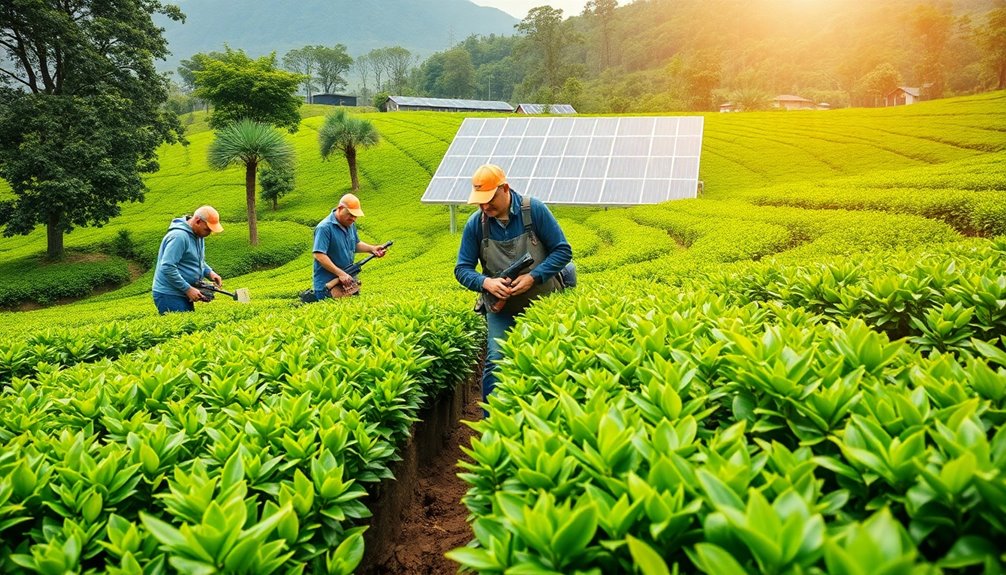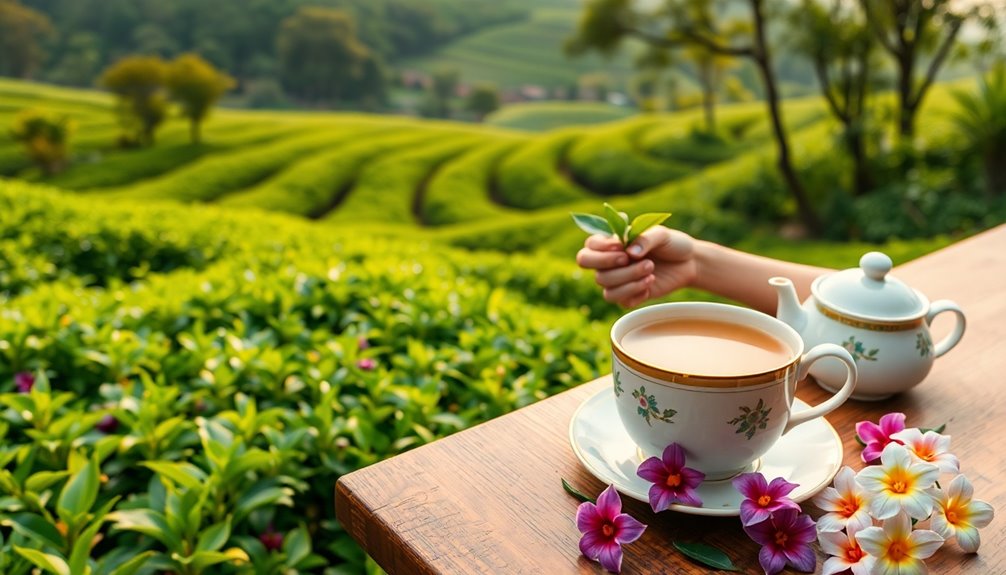Technology plays a big role in making tea production more sustainable! Imagine using smart tools like drones and sensors to check how your crops are doing. These tools help farmers use less water and understand what their plants need. Eco-friendly packaging keeps the environment safe, too! There's also cool technology, like blockchain, that lets us trace tea from farm to cup. This means you can feel confident knowing your tea is sourced ethically. With all these advancements, tea farming becomes better for the planet and everyone involved. Stick around, and you'll discover even more exciting ways technology helps tea!
Key Takeaways
- Smart tools like sensors and drones enable precise monitoring of crop health, reducing chemical usage and promoting sustainable farming practices.
- Enhanced water management systems optimize resource usage, minimizing waste and ensuring sustainable irrigation for tea cultivation.
- Eco-friendly packaging innovations reduce environmental impact, utilizing biodegradable materials to support sustainability in the tea supply chain.
- Blockchain technology ensures traceability in production, allowing consumers to verify sustainable practices and ethical sourcing of tea products.
- Precision agriculture techniques, including GPS and soil monitoring, increase yields and improve plant health while reducing resource inputs and environmental harm.
Introduction

In recent years, the tea industry has embraced innovative technologies to enhance sustainability and efficiency. You might be surprised to learn how these changes are making a big difference! Farmers are using smart tools, like sensors and drones, to monitor their crops. This means they can see what their tea plants need without wasting resources. Isn't that cool?
Additionally, technology helps with water management, which is super important. With new systems, farmers can use just the right amount of water, making sure each drop counts. This not only saves water but also helps the plants grow better!
Another exciting development is the use of eco-friendly packaging. Many tea companies are switching to biodegradable materials. This way, when you enjoy your favorite tea, you're also helping the planet!
Tea Cultivation's Environmental Impact

The environmental impact of tea cultivation can be significant, especially when traditional practices are involved. You might be surprised to learn that some methods can harm the soil and water sources. When farmers use too many chemicals, it can lead to water pollution, affecting nearby plants and animals. This isn't just bad news for nature; it can also impact the taste and quality of the tea you love!
Moreover, deforestation is another concern. When land is cleared for tea plantations, it can destroy habitats for wildlife and reduce biodiversity. You might picture lush green hills, but behind that beauty, there could be environmental damage.
However, there's hope! Sustainable practices can help minimize these impacts. By using organic farming methods, farmers can protect the soil and water. Crop rotation and planting cover crops can improve soil health and keep it rich.
Plus, these methods can make tea cultivation more resilient to climate change. So, when you enjoy your cup of tea, remember that choosing sustainably produced tea supports both the environment and the farmers. You can sip with a smile, knowing you're making a positive difference!
Precision Agriculture Enhances Yields

While traditional farming methods often rely on broad approaches, precision agriculture tailors practices to the specific needs of tea plants and their environment, significantly enhancing yields.
Imagine being able to give each tea plant exactly what it needs! With tools like GPS and sensors, you can monitor soil health, moisture levels, and even weather patterns. This technology helps you make smart decisions about when to water, fertilize, and harvest.
By observing these details, you'll notice that your tea plants thrive. Healthier plants mean more leaves to pick, and more leaves lead to better tea! Plus, when you apply fertilizers and pesticides only when needed, you save money and protect the environment. It's a win-win!
You can also track growth patterns, which helps you understand how to improve your practices over time. Isn't that exciting?
Precision agriculture turns farming into an adventure, allowing you to explore new ways to boost your tea yields. So, embrace this technology and watch your tea garden flourish like never before!
With a little help from precision agriculture, you're on your way to producing the best tea possible.
Blockchain for Traceability
As consumers increasingly demand transparency in their food sources, blockchain technology emerges as a powerful tool for traceability in sustainable tea production.
Imagine being able to follow your favorite tea from the moment it's picked to when it's packed and shipped to your store! With blockchain, you can do just that.
Blockchain acts like a digital notebook, where all the steps in tea production are recorded. Each time the tea moves—whether it's picked, processed, or packaged—a new note is added to the chain.
This means you can see exactly where your tea comes from and how it's made. Isn't that cool?
This technology helps everyone involved, from farmers to consumers. Farmers can prove they're using sustainable practices, while you get to enjoy tea that's not only delicious but also ethically sourced.
Plus, if there's ever a problem, tracing it back becomes super easy.
Labor Rights in Tea Farming

Labor rights in tea farming are crucial for ensuring fair treatment and fair wages for workers in an industry often marked by exploitation. When you sip your favorite cup of tea, think about the people behind it. Many tea workers face long hours, low pay, and unsafe conditions. It's important to know that they deserve better!
Fighting for labor rights means creating a safe and happy environment for these workers. They should have access to clean water, proper housing, and healthcare. Fair wages allow them to support their families and lead healthier lives.
You might be surprised to learn that when workers are treated well, they feel more motivated and productive!
Supporting companies that prioritize labor rights can help change the tea industry for the better. You can join in by choosing brands that are committed to ethical practices. By doing this, you're not only enjoying your tea but also standing up for those who grow it.
Together, we can make a difference in their lives. So next time you enjoy a warm cup, remember the hardworking individuals who made it possible, and let's cheer for their rights!
Practical Applications

In today's world, sustainable tea production increasingly relies on practical applications of technology to improve both environmental and social outcomes.
You'll find that farmers are using drones to monitor tea plantations. These flying devices help spot problems like pests or diseases early on, which means crops can stay healthy without relying too much on harmful chemicals.
Also, think about the role of mobile apps. They allow farmers to share knowledge easily. With just a tap, you can learn about the best practices for tea growing. This helps everyone in the community grow better tea while taking care of the planet.
Water-saving irrigation systems are another exciting advancement. These systems use sensors to deliver just the right amount of water to each plant. This not only saves water but also ensures your tea plants thrive.
Frequently Asked Questions
How Does Technology Affect Tea Flavor Profiles?
Technology can really change how tea tastes! When you brew tea, different machines help control the temperature and steeping time. This means you can get the best flavor from the leaves.
Plus, technology lets tea makers experiment with new blends and flavors. They can even use sensors to monitor the tea's quality.
What Are the Costs Associated With Adopting Sustainable Technology in Tea Farming?
When you think about adopting sustainable technology in tea farming, costs can vary.
You might need to invest in new tools, like solar panels or drip irrigation systems, which can be pricey at first. However, these tools can save money in the long run by reducing water and energy use.
Plus, there's often training involved for farmers. While it sounds like a lot, the benefits for the environment make it worthwhile!
Can Technology Help Mitigate Climate Change Effects on Tea Production?
Absolutely! Technology can really help with climate change effects on tea production.
For instance, using sensors in the fields lets farmers monitor soil moisture and temperature. This helps them know when to water their plants.
Drones can also check for pests without using harmful chemicals.
Plus, data analysis helps farmers predict weather patterns, so they can plan better.
With these tools, you're not just growing tea; you're protecting the planet, too!
Which Countries Lead in Technology Adoption for Sustainable Tea Practices?
When you think about countries leading in tech for sustainable tea practices, India and China come to mind.
They're using cool innovations like smart irrigation and drones!
Kenya's also making waves with eco-friendly farming methods.
Sri Lanka is putting tech to work, too, helping farmers grow better tea.
These countries show how technology can help create a greener future for tea.
Isn't it exciting to see such positive changes happening?
How Do Consumers Influence Technology Use in Sustainable Tea Production?
Consumers play a big role in how technology's used in sustainable practices!
When you choose eco-friendly products, companies notice. Your demand for better practices encourages farmers to adopt new technologies. You can share your thoughts online or support brands that care about the planet.
Every time you buy sustainably, you're sending a message. It's exciting to think that your choices can help make a difference in the world of tea production!
Conclusion
In conclusion, technology is making tea production better for our planet! With tools like precision agriculture and blockchain, farmers can grow tea more efficiently and keep track of every step. Plus, these advancements help protect workers' rights. It's exciting to see how innovation can create a brighter future for tea lovers and the environment. So, next time you sip your favorite cup of tea, remember all the amazing ways technology is helping! Enjoy your tea adventure!










